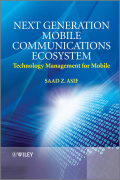
Next generation mobile communications ecosystem: technology management for mobile communications
Asif, Saad Z.
Taking an in-depth look at the mobile communications ecosystem, this book covers the two key components, i.e., Network and End-User Devices, in detail. Within the network, the sub components of radio access network, transmission network, core networks, services and OSS are discussed; component level discussionalso features antenna diversity and interference cancellation techniques for smart wireless devices. The role of various standard development organizationsand industry forums is highlighted throughout. The ecosystem is strengthened with the addition of the Technology Management (TM) component dealing mostly with the non-technical aspects of the underlying mobile communications industry. Various aspects of TM including technology development, innovation management, knowledge management and more are also presented. * Focuses on OFDM-based radio technologies such as LTE & WiMAX as well as MBWA (Mobile Broadband Wireless Access) * Provides a vital addition to the momentum of EVDO and its migration towards LTE * Emphasis on radio, core, operation, architectural and performance aspects of two next generation technologies - EPS and WiMAX * Includes discussion of backhaul technologies and alternatives as well as issues facedby operators switching to 3G and Next Generation Mobile Networks * Cutting-edge research on emerging Gigabit Ethernet Microwave Radios and Carrier Ethernettransport technologies Next Generation Mobile Communications Ecosystem servesas a practical reference for telecom associated academia and industry to understanding mobile communications in a holistic manner, as well as assisting in preparing graduate students and fresh graduates for the marketplace by providing them with information not only on state-of-the-art technologies and standards but also on TM. By effectively focusing on the key domains of TM this book will further assist companies with improving their competitiveness in the longrun. Importantly, it will provide students, engineers, researchers, technology managers and executives with extensive details on various emerging mobile wireless standards and technologies INDICE: Chapter 1 Introduction 1.1 Mobile Communications Ecosystem 1.2 Book Overview Chapter 2 OFDM and OFDMA 2.1 Introduction 2.2 Technical Background 2.3 Principles of OFDM 2.4 OFDM Advantages 2.5 OFDM Impairments and Potential Remedies 2.6 Multi Access Scheme OFDMA 2.7 Why OFDMA for NGMN 2.8 Summary Insights Chapter 3 3GPP Evolved Packet System (EPS) 3.1 Introduction 3.2 3GPP Releases 3.3 3GPP LTE 3.4 LTE Air Interface 3.5 PHY Layer 3.6 Layer 2 3.7 RRC Sublayer 3.8 EPS Architecture 3.9 Key Attributes of E-UTRA 3.10 LTE Performance 3.11 3GPP Roadmap Evolution 3.12 Industry Outlook 3.13 Summary Insights Chapter 4 IEEE 802.16 WiMAX 4.1 Introduction 4.2 Air Interface 4.3 Advanced Features of Mobile WiMAX 4.4 Network Architecture 4.5 Performance 4.6 WiMAX Certification 4.7 Industry Outlook 4.8 Next Steps/Evolution 4.9 Summary Insights Chapter 53GPP2 CDMA2000 1x EV-DO 5.1 Introduction 5.2 1xEV-DO (Revisions 0 and A) 5.3 EV-DO Revision B 5.4 UMB (EVDO Revision C) 5.5 CDMA450 5.6 EVDO Architecture 5.7 EVDO Revisions Comparison 5.8 CDMA2000 Evolution Wideband Mode 6.6 625k-MC (625kiloHertz-spaced MultiCarrier) Mode 6.7 802.20 Network Architecture 6.8 Performance 6.9 Industry Outlook 6.10 Summary Insights Chapter 7 Transmission Networks 7.1 Introduction 7.2 Market Drivers and Challenges 7.3 Backhaul Network7.4 Metro Regional and Aggregation Transport Networks 7.5 Backbone Transport Network 7.6 Transport Network Evolution 7.7 Industry Outlook 7.8 Summary Insights Chapter 8 Core Networks & Operating Support Systems 8.1 Introduction 8.2 Core Network 8.3 Operation Support System 8.4 Industry Outlook 8.5 Summary Insights Chapter 9 IMS, Services & Applications 9.1 Introduction 9.2 What is IMS? 9.3 3GPP IMS 9.4 3GPP IMS and WiMAX 9.5 3GPP2 Multi Media Domain (MMD) 9.6 IMSin Other Standard Bodies 9.7 Common IMS 9.8 Protocols 9.9 Services and Applications 9.10 Challenges 9.11 IMS absence in Existing 3G Networks 9.12 Advance Services and Applications 9.13 Mobile Content Development 9.14 Key SDOs and Forums 9.15 Industry Outlook 9.16 Summary Insights Chapter 10 Smart Wireless Devices 10.1 Introduction 10.2 3G Wireless Devices 10.3 Mobile Software Platform 10.4 RF and Processors 10.5 Signal Processing 10.6 User Interface 10.7 Power Supply 10.8 Mobile Device Management 10.9 Mobile Performance Enhancement Techniques 10.10 Device Development Organizations 10.11 Devices (3GPP, 3GPP2, & WiMAX) 10.12 Industry Outlook 10.13 Summary Insights Chapter 11 E2E Network Architecture & Mobility Management 11.1 Introduction 11.2 E2E EPS Architecture 11.3 E2E WiMAX Architecture 11.4 Mobility Management 11.5 EPS and WiMAX Interworking11.6 EPS and EVDO (HRPD) Interworking 11.7 WiMAX and EVDO Interworking 11.8 Key Interoperability Challenges 11.9 Fixed Mobile Convergence 11.10 Industry Outlook 11.11 Summary Insights Chapter 12 Technology Management 12.1 Introduction 12.2 Technology Strategy 12.3 Technology Development 12.4 New Product Development (NPD) 12.5 Innovation Management 12.6 Knowledge Management 12.7 CulturalManagement 12.8 Technology Foresight 12.9 Technology Roadmapping 12.10 Technology Commercialization 12.11 Managed Services 12.12 Hypothetical Case 12.13 Industry Outlook 12.14 Summary Insights Chapter 13 Recap & Future Outlook 13.1 Chapters Recap 13.2 Formalization of TM for Mobile Communications Ecosystem 13.3 4G 13.4 Mobile Network Infrastructure Sharing 13.5 Connecting the Next Billion Users 13.6 Green Power for Mobile 13.7 Media and Telecom Convergence 13.8 Future Outlook
- ISBN: 978-0-470-74746-9
- Editorial: John Wiley & Sons
- Encuadernacion: Cartoné
- Páginas: 432
- Fecha Publicación: 29/10/2010
- Nº Volúmenes: 1
- Idioma: Inglés
